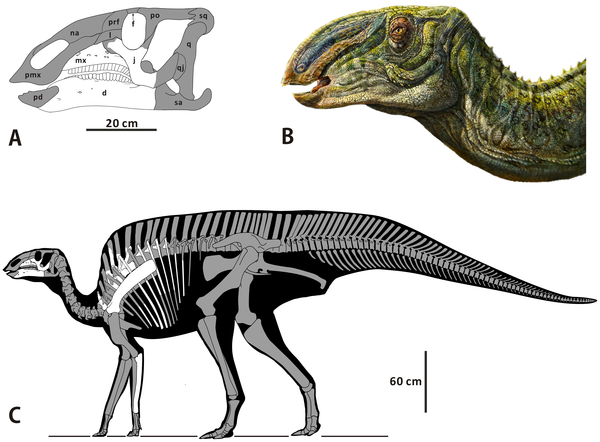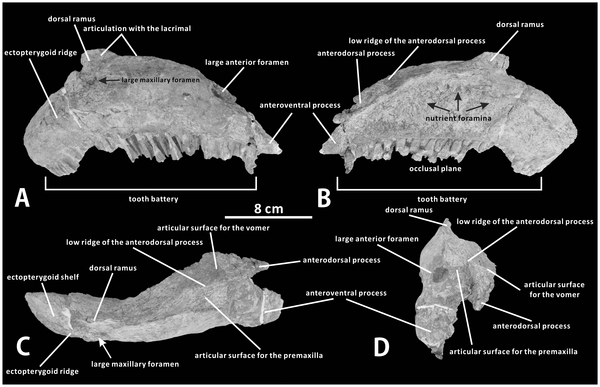Southwestern Henan Province in central China contains many down-faulted basins, including the Xixia Basin where the Upper Cretaceous continental sediments are well exposed. The Majiacun Formation is a major dinosaur-bearing stratigraphic unit that occurs in this basin.
Methodology/Principal Findings
A new basal hadrosauroid dinosaur, Zhanghenglong yangchengensis gen. et sp. nov., is named based on newly collected specimens from the middle Santonian Majiacun Formation of Zhoujiagou Village, Xixia Basin. Two transitional features between basal hadrosauroids and hadrosaurids are attached to the diagnosis of the new taxon, namely five maxillary foramina consisting of four small scattered ones anteroposteriorly arranged in a row and a large one adjacent to the articular facet for the jugal, and dentary tooth crowns bearing both median and distally offset primary ridges. Zhanghenglong also displays a unique combination of plesiomorphic and derived features of hadrosauroids, and is clearly morphologically transitional between basal hadrosauroids and hadrosaurids. Furthermore, some measurement attributes in osteology are applied to the quantitative analysis of Zhanghenglong. For these attributes, the partition of the dataset on most hadrosauroid species resulting from model-based cluster analysis almost matches taxonomic separation between basal hadrosauroids and hadrosaurids. Data of Zhanghenglong on selected measurement attributes straddle the two combinations of intervals of partitioned datasets respectively related to basal hadrosauroids and hadrosaurids. This condition is similar to mosaic evolution of morphological characters present in the specimens of the taxon. The phylogenetic analysis of Hadrosauroidea recovers a clade composed of Zhanghenglong, Nanyangosaurus, and Hadrosauridae with an unresolved polytomy.

(A) Skull reconstruction of Z. yangchengensis in left lateral view. (B) Restoration of the head and the anterior part of the neck of Z. yangchengensis in left lateral view. (C) Skeleton reconstruction of Z. yangchengensis in left lateral view. Bones in white are preserved in the specimens of Z. yangchengensis (XMDFEC V0013 and V0014). Bones in grey are unknown. Abbreviations: d, dentary; f, frontal; j, jugal; l, lacrimal; mx, maxilla; na, nasal; pd, predentary; pmx, premaxilla; po, postorbital; prf, prefrontal; q, quadrate; qj, quadratojugal; sa, surangular; sq, squamosal.
doi:10.1371/journal.pone.0098821.g002

Maxilla of Zhanghenglong yangchengensis.
Right maxilla (XMDFEC V0013, holotype) in lateral (A), medial (B), dorsal (C), and anterior (D) views.
doi:10.1371/journal.pone.0098821.g003
Conclusions/Significance
Zhanghenglong is probably a relatively derived non-hadrosaurid hadrosauroid, based on the inferences made from the morphological comparisons, quantitative evaluation of measurements, and cladistic analysis. In combination with information on the stratigraphy, phylogeny and biogeography, the material of Zhanghenglong provides direct evidence for the hypothesis that hadrosaurids might have originated in Asia.
Citation: Xing H, Wang D, Han F, Sullivan C, Ma Q, et al. (2014) A New Basal Hadrosauroid Dinosaur (Dinosauria: Ornithopoda) with Transitional Features from the Late Cretaceous of Henan Province, China. PLoS ONE 9(6): e98821. doi:10.1371/journal.pone.0098821
Editor: David C. Evans, Royal Ontario Museum, Canada



 June 29th, 2014
June 29th, 2014  Riffin
Riffin  Posted in
Posted in  Tags:
Tags: 